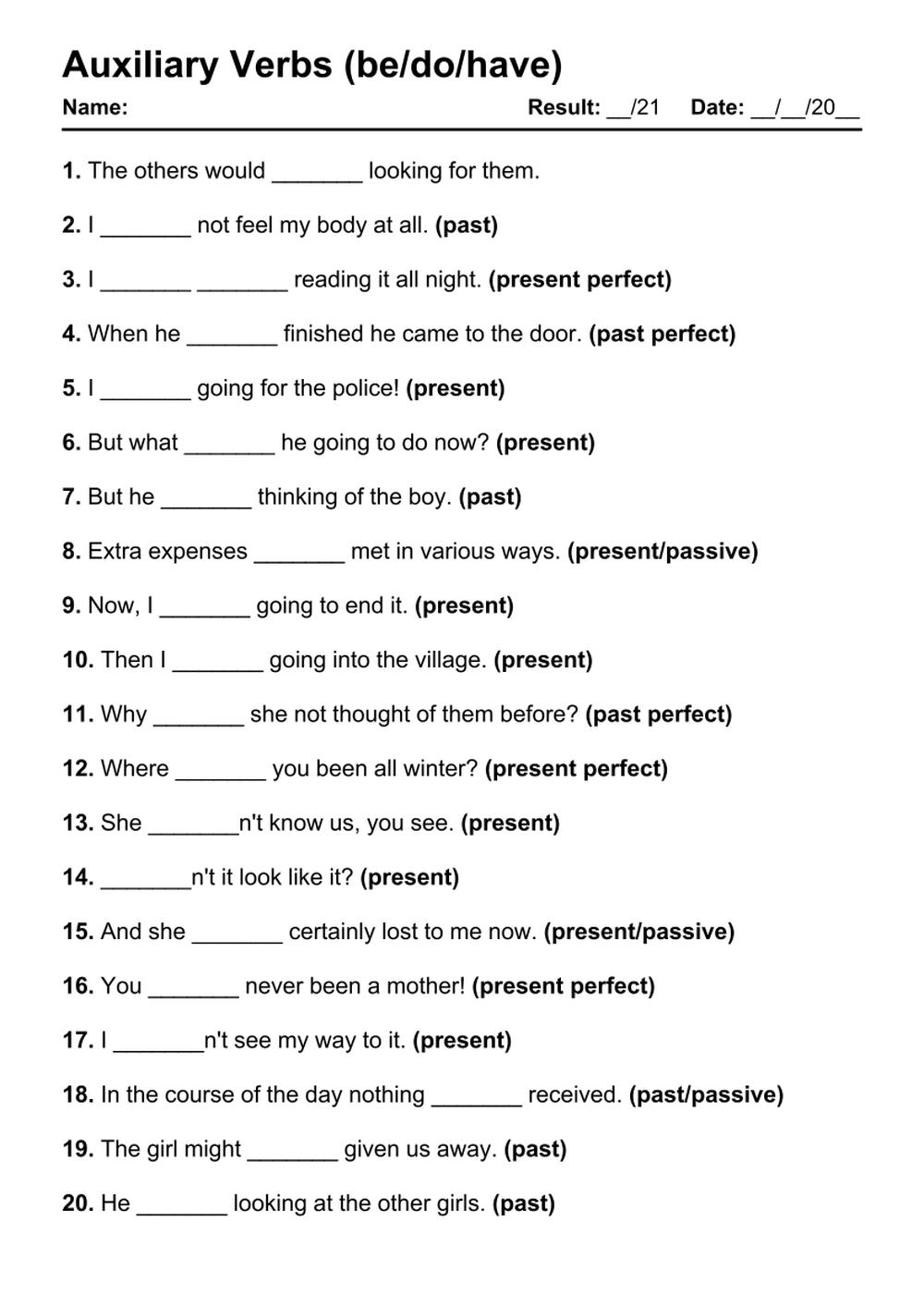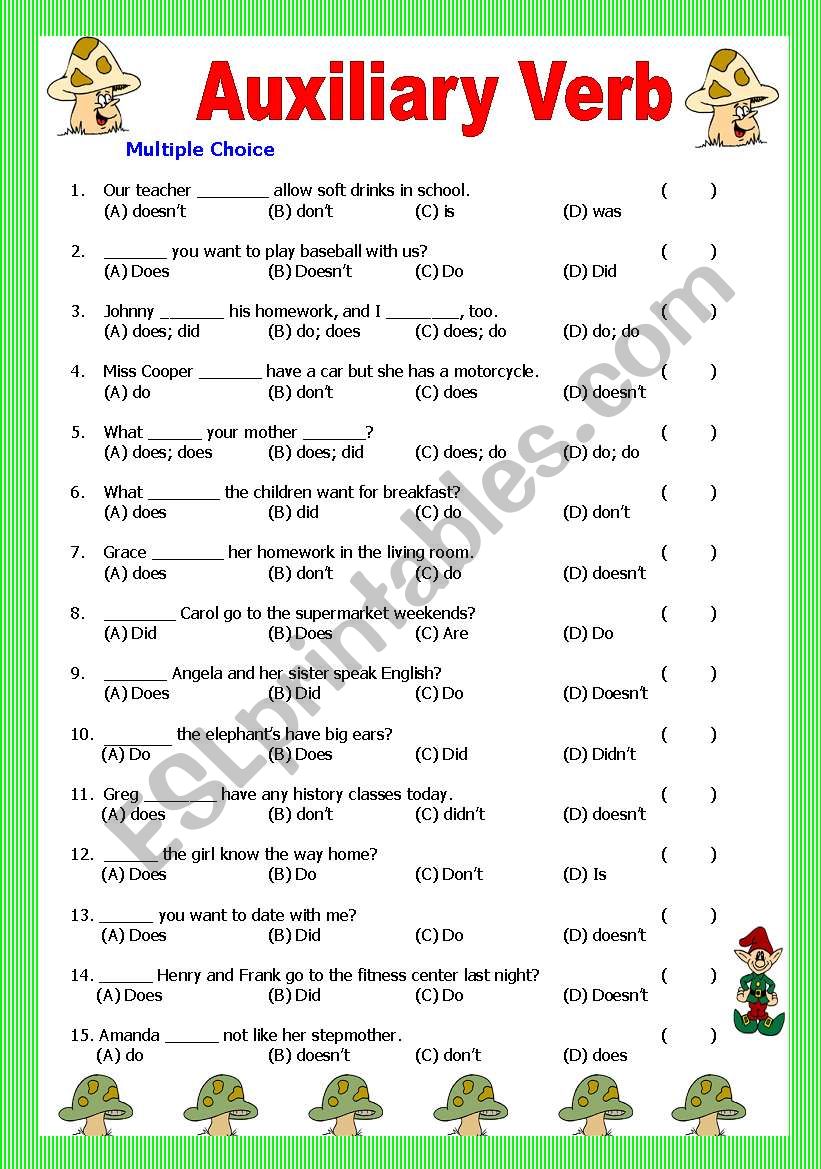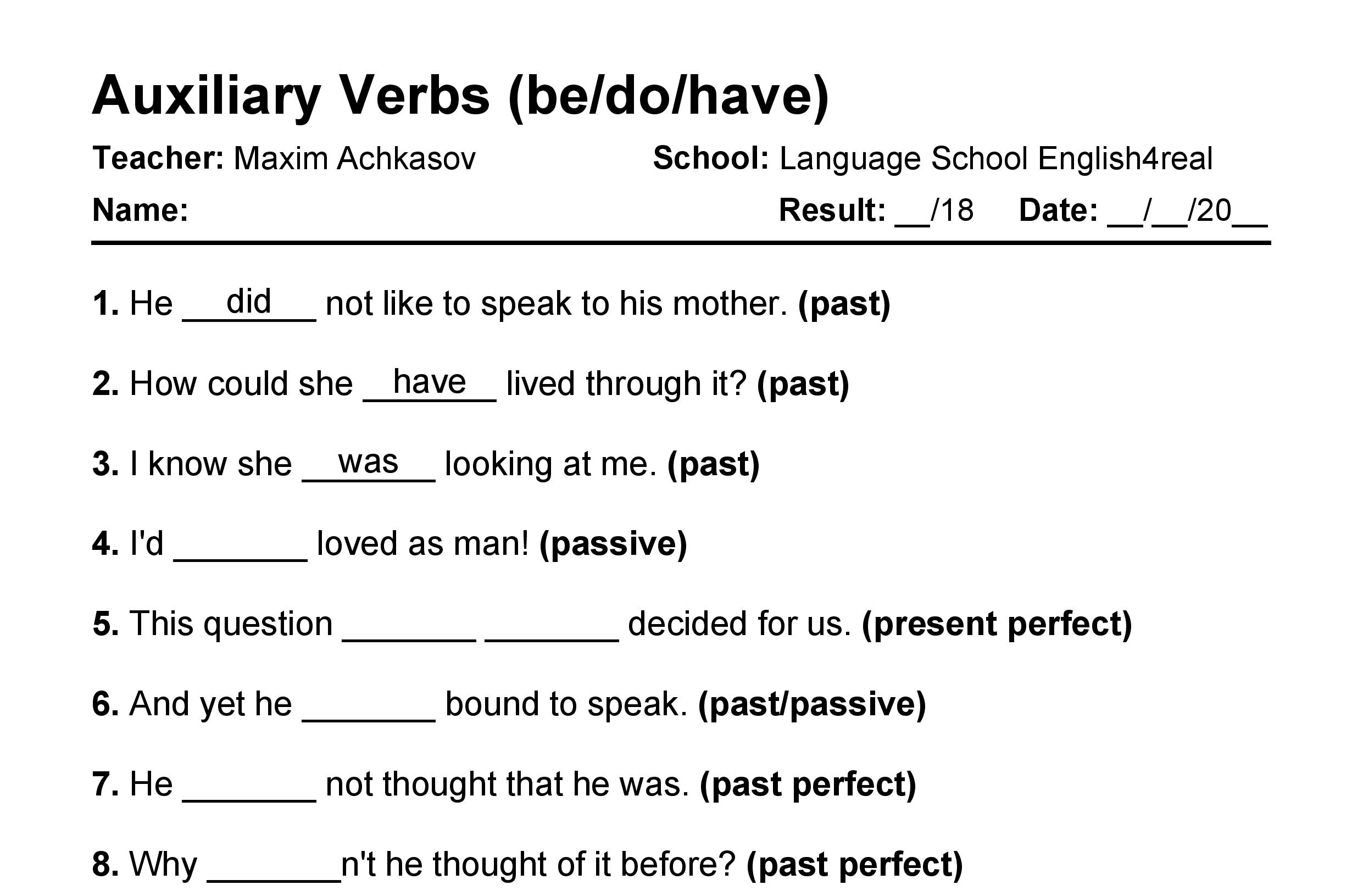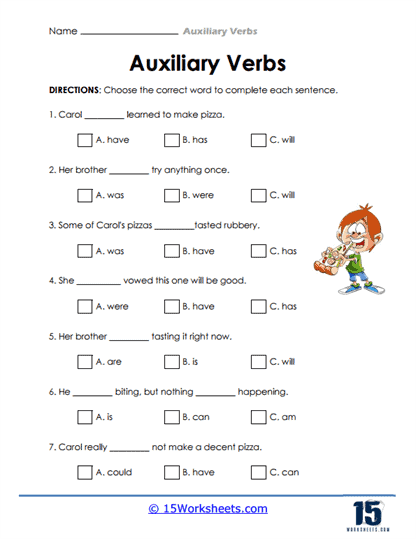
Mastering the Backbone of English: The Power of Grammar Worksheets: Auxiliary Verbs
English grammar, with its intricate rules and seemingly endless exceptions, can often feel like a daunting maze. Yet, at its core lies a logical structure, and understanding its fundamental building blocks is the key to unlocking fluency and precision. Among these critical components are auxiliary verbs – the unsung heroes that lend nuance, tense, and mood to our sentences. While textbooks provide the theory, true mastery often comes through active application, and this is precisely where the power of Grammar Worksheets: Auxiliary Verbs comes into play.
This comprehensive article will delve into the indispensable role of auxiliary verbs, explore the common challenges learners face, and demonstrate how well-designed Grammar Worksheets: Auxiliary Verbs serve as an unparalleled tool for effective learning and retention.
The Indispensable Role of Auxiliary Verbs

Auxiliary verbs, often called "helping verbs," are verbs that accompany a main verb to form a complete verb phrase. They don’t carry meaning on their own in the same way main verbs do, but they are crucial for conveying information about tense, mood, voice, and emphasis. Without them, English sentences would be clunky, ambiguous, and severely limited in their expressive capabilities.

There are two main categories of auxiliary verbs:

-

Primary Auxiliaries: These are
be,do, andhave.- Be (am, is, are, was, were, been, being): Used to form continuous tenses (e.g., "She is reading"), passive voice (e.g., "The book was written"), and to express states of being (though often as a main verb then).
- Do (do, does, did): Essential for forming questions (e.g., "Do you understand?"), negative statements (e.g., "I did not go"), and for adding emphasis (e.g., "I do believe you").
- Have (have, has, had): Used to form perfect tenses (e.g., "They have finished," "He had left").

-
Modal Auxiliaries: These express possibility, necessity, permission, ability, obligation, and more. Common modals include
can,could,will,would,shall,should,may,might,must, andought to.
Can/Could: Ability, possibility, permission. ("I can swim." "It could rain.")Will/Would: Future actions, willingness, polite requests. ("She will arrive soon." "Would you mind?")Shall/Should: Suggestion, obligation, advice. ("We shall overcome." "You should study harder.")May/Might: Possibility, permission. ("It may be true." "I might visit.")Must/Ought to: Obligation, strong probability. ("You must complete the task." "You ought to apologize.")



Understanding these categories and their specific functions is the first step. The next, and arguably more challenging, step is to internalize their usage so that they become second nature.
Why Auxiliary Verbs Pose a Challenge
Despite their foundational role, auxiliary verbs frequently trip up English learners, both native and non-native speakers. Several factors contribute to this difficulty:
- Conjugation and Agreement: Primary auxiliaries change form based on the subject (I am, he is, they are) and tense (I do, he does, we did). Learners must master these variations.
- Placement in Sentences: Auxiliaries often precede the main verb, but their position shifts dramatically in questions (Auxiliary + Subject + Main Verb) and negative sentences (Subject + Auxiliary + Not + Main Verb). This inversion can be counter-intuitive.
- Subtle Nuances of Modals: The difference between "may," "might," and "could" for possibility, or "should," "must," and "ought to" for obligation, can be incredibly subtle and context-dependent. Mastering these nuances requires extensive exposure and practice.
- Contractions: Native speakers frequently use contractions (e.g., "don’t," "isn’t," "he’ll"), which can make it harder for learners to identify the individual auxiliary verb.
- Distinguishing from Main Verbs: Sometimes,
be,do, andhaveact as main verbs (e.g., "I am a student," "I do my homework," "I have a car"). Learners must discern when they are acting as auxiliaries and when they are the primary action. - Overuse or Underuse: Learners might omit necessary auxiliaries or use too many, leading to grammatically incorrect or awkward sentences.
Given these complexities, a systematic and repetitive approach to learning is essential. This is where Grammar Worksheets: Auxiliary Verbs become an invaluable resource.
The Unparalleled Power of Grammar Worksheets: Auxiliary Verbs
Worksheets provide a structured environment for active learning, moving beyond passive reading or listening. For auxiliary verbs, this active engagement is critical. Here’s why Grammar Worksheets: Auxiliary Verbs are so effective:
- Active Recall and Application: Instead of merely recognizing a correct sentence, worksheets demand that learners actively produce the correct form or choose the appropriate auxiliary. This active recall strengthens memory pathways.
- Repetition and Reinforcement: Grammar is largely about habit formation. Worksheets offer numerous opportunities to repeat the correct usage of auxiliaries in various contexts, embedding the patterns into the learner’s linguistic "muscle memory."
- Identification of Weak Spots: As learners complete exercises, they quickly discover which specific auxiliary verbs or grammatical constructions (e.g., questions with "do") they struggle with. This self-assessment allows them to focus their efforts.
- Immediate Feedback: Most worksheets come with answer keys, allowing learners to check their work immediately. This instant feedback loop is crucial for correcting mistakes before they become ingrained habits.
- Variety of Exercise Types: Good Grammar Worksheets: Auxiliary Verbs don’t just offer one type of exercise. They present diverse formats that challenge learners in different ways, ensuring a comprehensive understanding.
- Confidence Building: Successfully completing exercises builds confidence, motivating learners to tackle more complex grammatical structures.
Types of Exercises Found in Effective Grammar Worksheets: Auxiliary Verbs
To truly address the multifaceted challenges of auxiliary verbs, a robust set of worksheets will include a variety of exercise types, each targeting a specific aspect of usage:
-
Fill-in-the-Blanks (Simple & Contextual):
- Simple: "She ____ (be) reading a book." (Answer: is)
- Contextual: "Yesterday, I (do) not feel well, so I (have) to stay home. My friend (call) me later to see if I (be) feeling better." These force learners to consider tense and subject-verb agreement.
-
Multiple Choice:
- "He ____ finished his homework." (a) has (b) do (c) is (d) will
- "____ you like some tea?" (a) Do (b) Have (c) Will (d) Are
These test recognition and quick decision-making based on context.
-
Sentence Transformation:
- Positive to Negative: "They are going to the party." -> "They ____ going to the party." (Answer: are not)
- Statement to Question: "She can speak French." -> "____ she speak French?" (Answer: Can)
- Active to Passive Voice: "The dog chased the cat." -> "The cat ____ chased by the dog." (Answer: was)
These exercises reinforce the structural changes involving auxiliaries.
-
Error Correction:
- "He don’t like coffee." (Correction: He doesn’t like coffee.)
- "They has seen that movie." (Correction: They have seen that movie.)
- "I must to go now." (Correction: I must go now.)
This type of exercise develops a critical eye for grammatical accuracy.
-
Sentence Completion/Creation:
- "If I had known, I ____." (e.g., would have come.)
- "You should ____." (e.g., study harder.)
- "Create a question using ‘did’ and ‘go’." (e.g., Did you go to the store?)
These push learners to produce full, grammatically correct sentences using the target auxiliary verbs.
-
Matching:
- Match modal verbs to their function (e.g., "Can" -> Ability, "Must" -> Obligation).
- Match sentence halves where one half contains an auxiliary and the other completes the thought.
-
Dialogue Completion:
- A: " you seen my keys?" B: "No, I not."
These mimic real-life conversational scenarios, integrating auxiliaries into natural language use.
- A: " you seen my keys?" B: "No, I not."
Designing and Utilizing Effective Grammar Worksheets: Auxiliary Verbs
Whether you’re an educator creating materials or a self-learner seeking the best resources, consider these principles for maximizing the effectiveness of Grammar Worksheets: Auxiliary Verbs:
- Clear Instructions: Ambiguous instructions can hinder learning. Ensure that what the learner needs to do is explicitly stated.
- Gradual Difficulty: Start with simpler concepts and slowly introduce more complex ones. For instance, begin with
beanddoin simple present, then move to perfect tenses, and finally to modals with their nuances. - Contextual Relevance: Isolated sentences are less effective than those embedded in short paragraphs or dialogues. Context helps learners understand why a particular auxiliary is used.
- Variety is Key: As discussed, don’t rely on just one type of exercise. Mix and match to keep learners engaged and to target different skills.
- Provide Answer Keys: Self-correction is a powerful learning tool. Make sure answers are readily available for immediate feedback.
- Integrate with Communicative Tasks: Worksheets build foundational knowledge. Encourage learners to then use the learned structures in speaking and writing activities. For example, after a worksheet on modal verbs of possibility, ask them to discuss what they might do next weekend.
- Regular, Focused Practice: Short, regular sessions with Grammar Worksheets: Auxiliary Verbs are more effective than infrequent, long ones. Consistency builds habit.
- Feedback and Review: For classroom settings, review answers as a group. For self-learners, periodically revisit older worksheets to ensure retention.
Beyond the Worksheet: A Holistic Approach
While Grammar Worksheets: Auxiliary Verbs are incredibly valuable, they are part of a larger ecosystem of language learning. To truly master auxiliary verbs, learners should also:
- Read Extensively: Observe how auxiliary verbs are used naturally in books, articles, and online content.
- Listen Actively: Pay attention to how native speakers use auxiliaries in conversations, podcasts, and media.
- Speak and Write: Actively try to incorporate the auxiliary verbs learned from worksheets into their own spoken and written English. Making mistakes and being corrected is part of the process.
- Use Digital Tools: Many online platforms offer interactive exercises and quizzes that function like digital worksheets, often with immediate scoring and explanations.
Conclusion
Auxiliary verbs are the invisible architects of English sentences, providing the essential framework for expressing complex ideas, tenses, and moods. Their mastery is non-negotiable for anyone aspiring to speak or write English with accuracy and confidence. While their nuances can be challenging, the systematic and repetitive practice offered by well-designed Grammar Worksheets: Auxiliary Verbs provides an unparalleled path to proficiency.
By engaging actively with diverse exercises, understanding the underlying rules, and consistently reinforcing correct usage, learners can transform their understanding from theoretical knowledge to instinctive application. Embrace the power of Grammar Worksheets: Auxiliary Verbs, and watch your command of English grammar flourish.
